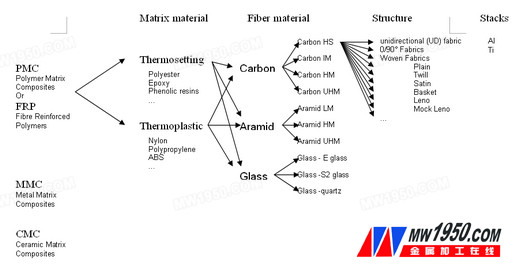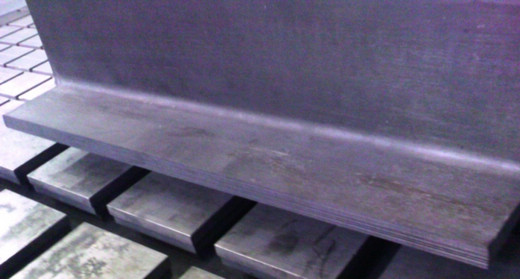The composite material is a combination of two different materials to form a new material that has more properties than the original two matrix materials. As early as in ancient Egypt, humans used mud and straw to form the earliest "composite", which exceeded the mud and wheat straw itself.
Modern common composite materials are classified into plastic-based composite materials according to different matrix materials (this article only discusses plastic-based composite materials), metal-based composite materials, ceramic-based composite materials, etc.; plastic-based composite materials are based on different materials incorporated into the matrix. Divided into carbon fiber, glass fiber (commonly known as FRP), aramid and other materials. There are many different materials superimposed, such as carbon fiber + aluminum alloy, carbon fiber + honeycomb material, glass fiber + titanium alloy and other materials.
Composite materials can be designed according to the strength requirements, design different fiber weaving direction, choose one direction to improve the material strength, divided into flat weave, twill weave, satin weave and other fiber laying direction methods. At the same time, the plastic matrix composite material can be further divided into a thermoplastic composite material and a thermosetting composite material according to the matrix; the thermoplastic material melts into a liquid at a high temperature and becomes a solid after being lower than the melting temperature. This process can be repeated, similar to small square ice cubes. Thermoset materials have different properties. Sufficient heat produces a chemical reaction called “crosslinking†and the material will deform forever. The heat is solid and solid with heat. After cross-linking, the thermoset material does not melt. At too high a temperature, the thermoset material will burn and the physical properties will decrease.

Composite materials have the following characteristics compared to metals:
· reduce weight;
· Reduce the number of parts, higher strength and rigidity;
· Better impact resistance, better fatigue resistance, better heat insulation and sound insulation, better vibration and noise attenuation, no current corrosion;
· Control the fiber direction to determine the characteristics of the material in different directions;
· Production of complex shape products.
Since the composite material is twisted together by two or more materials, and the fiber is laid in different directions and layers, it poses a higher challenge to the processing, and the following problems are easily generated during the processing: the tool is quickly worn and the burr is too large. The material is layered, the remaining fibers are not cut, and the processing is overheated.
Composite material processing is fundamentally different from metal working mechanism. The metal material is softer than the cutting tool during machining. During the cutting process, the material to be processed forms a continuous deformation along the shearing surface to form a continuous, jagged shape. Intermittent chip deformation. The composite material processing itself is a series of brittle failure processes, and the impact of the cutting edge causes the hard fibers to be pulverized to form powdery or brush-like debris.

Due to the high wear resistance of the composite, the tool is usually cut with a diamond coating or a PCD (polycrystalline diamond) tool. At the same time, in the processing of composite materials, a sharp cutting edge is required to cut the fibers. Diamond coating can significantly improve tool life, but the diamond coating needs to be treated before the coating to facilitate the adhesion of the coating. At the same time, the diamond coating itself has a certain thickness, so the diamond coating tool is less sharp, usually the cutting edge. The fillet is approximately 20um. The PCD tool is directly sharpened into a cutting edge, so it can be sharper, usually with a rounded corner of about 10um.
The choice of the two types of tools is usually determined according to the customer's production scale. If it is a small batch, multi-variety products can be processed with diamond-coated tools; if it is a large-scale stereotyped product, the efficiency can be PCD tools. For the processing of common carbon fiber composite materials, the diamond-coated tool milling line speed is about 200-400m/min, while the PCD tool milling line speed can reach 400-800m/min.
Composite materials are widely used in aerospace, energy (wind turbine blades), automotive, sports equipment, medical, yacht and other industries, the main purpose is the high strength and low density of materials. For example, the common carbon fiber is close to high-strength steel, and the density is 2.4g/cm 3 , which is lower than the density of the aluminum alloy; the density of the aramid material is lower to 1.3-1.4g/cm 3 .
Seco Tools offers a complete range of machined milling cutters and drills in two series, diamond coatings and PCD milling cutters, all of which are marketed as standard products.

There are five types of diamond coated milling cutters:
·Small spiral angle milling cutter: reduce axial cutting force and reduce burr. It can be applied to all plastic matrix composites and can process high silicon-containing aluminum alloy well.
·Small spiral angle ball end milling cutter: mainly used for processing material forming, such as aerial landing gear profile processing;
· Left-handed right-hand milling cutter: the material is cut at the intersection of the helix angles to completely offset the axial cutting force during the machining process, thus achieving the best surface quality, mainly used in the military industry;
·Pineapple milling cutter: use more left-handed teeth to press down the material to provide tooling rigidity and obtain better surface quality, mainly used for processing carbon fiber composite materials;
·Cut milling cutter: Zigzag cutting edge design, sharp cutting edge, light cut off, prevent overwhelming honeycomb, mainly used for processing, paper honeycomb panel, aluminum honeycomb panel and titanium honeycomb panel.
There are three types of PCD milling cutters:
·0 degree edge angle PCD milling cutter: various composite materials (including plastic matrix composites, metal matrix composites and ceramic matrix composites) for the most applications;
· Positive 3 degree edge angle PCD milling cutter: press down the material during processing to get the best upper surface quality;
• Negative 3 degree edge angle PCD milling cutter: Push the material up during machining to get the best upper surface quality.
There are two types of diamond coated drill bits:
· C1 drill tip design: formed by two apex angles, reducing axial cutting force, preventing delamination, for processing materials exported to composite materials;
· C2 drill tip design: formed by a 180 degree plane vertex angle and a small drill tip, better chip breaking and chip removal design to ensure the quality of the hole. It is suitable for processing superimposed composite materials with metal materials such as carbon fiber + aluminum alloy.
The PCD drill bit is designed for the composite drill tip. It can process the composite material export material, and can also process the metal material export material. It can also process the aramid hole and the best hole surface quality.
Seco Tools can also customize a variety of tools for processing composite materials according to customer requirements. Here are some examples of processing aerospace artifacts:

1. Customer: Russia RUSAVIAINTER
Material: carbon fiber
Seco Tools: JC840 left-handed right-hand milling cutter
Contour milling: ae=5 mm
Ap=Workpiece thickness 8mm
Vc=180 m/min
Fz=0.02
Climb milling, smooth cutting and good surface quality.
2. Airbus (France)

Material: carbon fiber
Machine tool: Jobs Jomach 159
Seco Tools: Standard PCD drill X31, diameter 6.35 mm
Line speed: Vc=180 m/min
Feed: 850 mm/min
Small cutting burrs, tool life of more than 60 minutes
3. Customer: An aero engine customer

Material: carbon fiber + aluminum honeycomb + carbon fiber board
Machine tool: Creno liner 5 axis
Seco Tools: JC860 Honeycomb Milling Cutter, 10mm diameter
Cutting width: milling slotting
Cutting depth: 40 mm
Line speed: 160 m/min
Feed rate: 300 mm/min
With the continuous reduction of the production cost of composite materials, the output has been greatly improved, and its application range has become wider and wider, and the processing challenges brought by it have also increased. We must continuously develop more new special-purpose composite tools to meet market demand.
Build-in Gas Hob,Gas Hob,Tempered Glass Built-in Gas Stove
Cylinder,TABLE TOP GAS STOVE Co., Ltd. , http://www.nscylinder.com